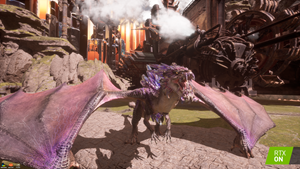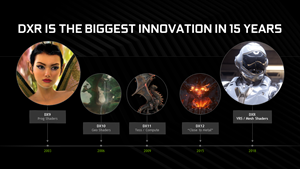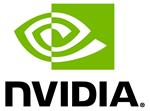SAN FRANCISCO, March 18, 2019 (GLOBE NEWSWIRE) -- Game Developers Conference—NVIDIA today announced several developments that reinforce
NVIDIA® GeForce® GPUs as the core platform that allows game developers to add real-time ray tracing effects to games.
The announcements, which build on the central role Microsoft DirectX™ Ray Tracing (DXR) plays in the PC gaming ecosystem, include:
- Integration of real-time ray tracing into Unreal Engine and Unity, the world’s most popular commercial game engines.
- NVIDIA is adding ray tracing support to GeForce GTX GPUs(1), giving developers a massive installed base of tens of millions of gamers.
- The introduction of NVIDIA GameWorks RTX™, a comprehensive set of tools and rendering techniques that help game developers add ray tracing to games.
- New games and experiences that showcase real-time ray tracing such as Dragonhound, Quake II RTX and others.
“When programmable shaders were introduced more than 15 years ago, they changed gaming forever. Today, real-time ray tracing is set to do the same thing — it represents the next landmark shift in game development,” said Matt Wuebbling, head of GeForce marketing at NVIDIA. “The breadth of industry adoption is remarkable —standard APIs, integration in major game engines, multiple AAA titles and support enabled in millions of hardware products. It all points to an exciting future for gamers.”
World’s Most Popular Game Engines Integrate Ray Tracing Support
Game engines are software development platforms that include all the core functionality developers need to create video games, from authoring and scripting to AI, physics and rendering.
Integrating into game engines new features such as real-time ray tracing can accelerate the development process. It also makes the features available to all users of a game engine, which include engineers and programmers as well as content creators and artists.
Two of the world’s most popular commercial game engines, Unreal Engine and Unity, have announced the imminent integration of ray tracing features, which game developers will use to add ray-traced effects that can run in real time on NVIDIA GeForce GPUs.
Unreal Engine 4.22 is available in preview now, with final release details expected in Epic’s GDC keynote on Wednesday. Starting on April 4, Unity will offer optimized, production-focused, real-time ray tracing support with a custom experimental build available on GitHub to all users with full preview access in the 2019.03 Unity release.
Real-time ray tracing support from other first-party AAA game engines includes DICE/EA’s Frostbite Engine, Remedy Entertainment’s Northlight Engine and engines from Crystal Dynamics, Kingsoft, Netease and others.
“In the near future, I believe every AAA title will incorporate real-time ray tracing,” said Jon Peddie, president of Jon Peddie Research. “The integration of real-time ray tracing by the two dominant game engines illustrates the game industry’s belief that real-time ray tracing is the future of gaming graphics. Historically, game engine integration represents a tipping point for technology and is followed by industry-wide adoption.”
Ray Tracing-Capable GPU Installed Base Grows to Tens of Millions
NVIDIA GeForce GTX GPUs powered by Pascal and Turing architectures(1) will be able to take advantage of ray tracing-supported games via a driver expected in April. The new driver will enable tens of millions of GPUs for games that support real-time ray tracing, accelerating the growth of the technology and giving game developers a massive installed base.
With this driver, GeForce GTX GPUs will execute ray traced effects on shader cores. Game performance will vary based on the ray-traced effects and on the number of rays cast in the game, along with GPU model and game resolution. Games that support the Microsoft DXR and Vulkan APIs are all supported.
However, GeForce RTX GPUs, which have dedicated ray tracing cores built directly into the GPU, deliver the ultimate ray tracing experience. They provide up to 2-3x faster ray tracing performance with a more visually immersive gaming environment than GPUs without dedicated ray tracing cores.
GameWorks RTX: Driving Development of Ray Traced Games
NVIDIA GameWorks RTX is a comprehensive set of tools that help developers implement real-time ray-traced effects in games. GameWorks RTX is available to the developer community in open source form under the GameWorks™ license and includes plugins for Unreal Engine 4.22 and Unity’s 2019.03 preview release.
Included in GameWorks RTX:
- RTX Denoiser SDK – a library that enables fast, real-time ray tracing by providing denoising techniques to lower the required ray count and samples per pixel. It includes algorithms for ray traced area light shadows, glossy reflections, ambient occlusion and diffuse global illumination.
- Nsight for RT – a standalone developer tool that saves developers time by helping to debug and profile graphics applications built with DXR and other supported APIs.
More details on GameWorks RTX is available at https://developer.nvidia.com/rtx.
New Ray-Traced Games and Experiences
GDC marks the debut of a variety of ray-traced experiences and games, including:
- Control — watch a new demo video from Remedy Entertainment featuring ray-traced global illumination, reflections and shadows.
- Dragonhound — visit NVIDIA’s GDC booth to check out Nexon’s upcoming online action RPG monster battle game that will feature real-time ray-traced reflections and shadows.
- Quake II RTX — uses ray tracing for all of the lighting in the game in a unified lighting algorithm called path tracing. The classic Quake II game was modified in the open source community to support ray tracing and NVIDIA’s engineering team further enhanced it with improved graphics and physics. Quake II RTX is the first ray-traced game using NVIDIA VKRay, a Vulkan extension that allows any developer using Vulkan to add ray-traced effects to their games.
Keep Current on NVIDIA
Subscribe to the
NVIDIA blog, follow us on
Facebook,
Twitter,
LinkedIn and
Instagram, and view NVIDIA videos on
YouTube and images on
Flickr.
About NVIDIA
NVIDIA’s (NASDAQ: NVDA) invention of the GPU in 1999 sparked the growth of the PC gaming market, redefined modern computer graphics and revolutionized parallel computing. More recently, GPU deep learning ignited modern AI — the next era of computing — with the GPU acting as the brain of computers, robots and self-driving cars that can perceive and understand the world. Today, NVIDIA is increasingly known as “the AI computing company.” More information at
http://nvidianews.nvidia.com/.
For further information, contact:
Bryan Del Rizzo
Director of Global PR, GeForce Products
NVIDIA Corporation
+1-510-331-8824
Email Contact
(1) GeForce GTX 1060 6GB GPUs or higher.
Certain statements in this press release including, but not limited to, statements as to: the benefits, impact, performance, abilities and availability of NVIDIA GeForce GPUs, NVIDIA GameWorks RTX and ray tracing; NVIDIA GeForce GPUs being the core platform to allow developers to add real-time ray tracing into games; the integration of ray tracing into Unreal Engine and Unity and new games showcasing it; NVIDIA adding ray-tracing support to GeForce GTX GPUs and giving developers a massive installed base of tens of millions of gamers; NVIDIA GameWorks RTX helping developers add DXR to games; ray tracing set to change gaming forever and representing a landmark shift in game development; the breadth of industry adoption of ray tracing and number of products that can support it; ray tracing in Unreal Engine and Unity enabling game developers to add ray tracing effects that can be run in real time; the availability of Unreal Engine and Unity; the belief that every AAA title will incorporate real-time ray tracing and the game industry’s belief that ray tracing is the future of gaming graphics; NVIDIA GeForce GTX GPUs expected ability to take advantage of ray tracing supported games; GeForce GTX GPU drivers enabling tens of millions of GPUs for games to support ray tracing which will accelerate the growth of the technology, and give game developers a massive install base and execute ray tracing on shader cores; game performance varying based on ray tracing in the game, GPU model and game resolution; GeForce GPUs providing faster and more visually immersive ray-tracing performance; the games that will be supported; and the new games that are being debuted at GDC and their features are forward-looking statements that are subject to risks and uncertainties that could cause results to be materially different than expectations. Important factors that could cause actual results to differ materially include: global economic conditions; our reliance on third parties to manufacture, assemble, package and test our products; the impact of technological development and competition; development of new products and technologies or enhancements to our existing product and technologies; market acceptance of our products or our partners' products; design, manufacturing or software defects; changes in consumer preferences or demands; changes in industry standards and interfaces; unexpected loss of performance of our products or technologies when integrated into systems; as well as other factors detailed from time to time in the most recent reports NVIDIA files with the Securities and Exchange Commission, or SEC, including, but not limited to, its annual report on Form 10-K and quarterly reports on Form 10-Q. Copies of reports filed with the SEC are posted on the company's website and are available from NVIDIA without charge. These forward-looking statements are not guarantees of future performance and speak only as of the date hereof, and, except as required by law, NVIDIA disclaims any obligation to update these forward-looking statements to reflect future events or circumstances.
© 2019 NVIDIA Corporation. All rights reserved. NVIDIA, the NVIDIA logo, GameWorks RTX, GeForce GTX, GeForce RTX, Hybrid Ray Traced Shadows, Nsight and RTX Denoiser are trademarks and/or registered trademarks of NVIDIA Corporation in the U.S. and other countries. Other company and product names may be trademarks of the respective companies with which they are associated. Features, pricing, availability and specifications are subject to change without notice.
Photos accompanying this announcement are available at:
http://www.globenewswire.com/NewsRoom/AttachmentNg/c9394686-a202-4349-b50a-9604acc1b812
http://www.globenewswire.com/NewsRoom/AttachmentNg/2e304836-7054-4373-8dad-116a26c7a246


